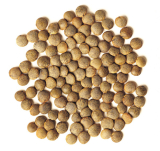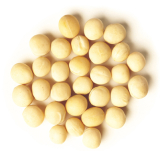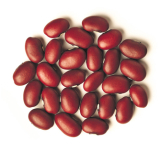
Pulses are part of the legume family, but the term “pulse” refers only to the dried seed. Dried peas, edible beans, lentils and chickpeas are the most common varieties of pulses. Pulse-based proteins are one of the most efficient, sustainable and scalable sources of protein we have to meet increasing demand.

Etymology of the word "Pulse"
The word pulse originates directly from the Latin puls meaning “thick gruel, porridge, mush.”

Pulses vs. Legumes
Legume refers to the plants whose fruit is enclosed in a pod.
Pulses are a subgroup of the legume family; refers only to the dried seed.

Crops of Ancient Origin
Pulses have been an essential part of the human diet for centuries.
The agricultural production of beans, chickpeas & lentils dates back to 7000 – 8000 B.C.
Learn more surprising facts about Pulses by downloading this FAO infographic [PDF] or visiting the Food and Agriculture Organization of the UN.
The Case for Pulses
Not only is demand for alternative (non-animal) protein at an all-time high, pulses have many:
Health Benefits
- help prevent and control NCDs
- help control blood pressure
- reduce BMI and risk of obesity
- reduce risk of diabetes and CVD
Nutrition Benefits
- increase satiety
- source of protein, micro-nutrients, complex carbohydrates, and fibre
Sustainability Benefits
- Nitrogen-fixing crop
- improved soil health
- require less water than other crops
More Facts
Sustainability
- Pulses use 1/2 to 1/10 the water of other sources of protein[1].
- Pulse crops are a low-risk, profitable way for farmers to diversify their crop production. Pulses have higher yields and improve the resiliency and efficiency of crop rotations, while requiring less water than many other crops.
- Studies show that pulses have a much lower carbon footprint than other sources of protein[2], and have the ability to fix nitrogen thereby requiring significantly less nitrogen fertilizers than other crops.
- Pulse crops produce a number of different compounds that feed soil microbes and benefit soil health.
Health and Nutrition
- Population survey data from North America has shown that consuming at least ½ cup of pulses per day is associated with higher intakes of fibre, protein, folate, zinc, iron and magnesium with lower levels of fat and saturated fat in the diet[3],[4].
- Pulses include soluble fibres, which assist in keeping cholesterol levels low, and insoluble fibres, which assist with digestion and regularity.
- Clinical research also shows that eating pulses can help manage blood sugar levels and blood pressure[5].




